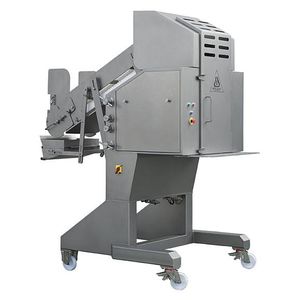
- Food industry
- Meat Processing
- Industrial meat tenderizer
- Metalquimia S.A.
- Products
- Catalogs
- News & Trends
- Exhibitions
Industrial meat tenderizer 360

Add to favorites
Compare this product
Characteristics
- Applications
- industrial
Description
The FILOGRIND/AUTOGRIND Mod. 360 Meat Tenderizers produce a multitude of cuts in the meat muscle, increasing the surface for extraction of myofibrillar proteins, reducing cooking loss, improving yield, minimizing defects in intermuscular binding and preventing the appearance of holes in the product’s slice, being specially adapted to the manufacture of sliced products, as well as to high-yield, in products with a high connective tissue content and cook-in products. Provides for a better distribution of the brine ingredients, improving standard deviations in the analytical results of the finished product.
System
•Two roller-knives (or roller-prongs) through which the meat passes by free-fall system.
•Adjustable distance between roller-knives.
•Compensatory shock absorber for tough meats.
•Possibility of blocking the movable roller to obtain a higher tenderization.
•Possibility of fixed roller speed variation to obtain a higher tenderization.
•Possibility of combining all the above options to obtain a much higher tenderization.
•Interchangeable blank roller for working with skin-on products.
•Easy access for maintenance, cleaning and sanitation.
•Upon request, an infeed conveyor belt can be provided.
Model AUTOGRIND: controlled by PLC and Display
Production capacity
Specially designed for coupling to high-production injector models such as MOVISTICK 30 PC, MOVISTICK 60 PC, MOVISTICK 120/3000 and MOVISTICK 3000 DUPLEX. Production capacity depends on the characteristics of the product and the production line. Please, consult with Metalquimia.
Related Searches
- Clipper
- Food clipper
- Steam cooking unit
- Vacuum stuffer
- Portioning machine
- Sausage vacuum stuffer
- Meat tumbler
- Vacuum meat tumbler
- Automatic portioning machine
- Pneumatic clipper
- Brine injector machine
- Meat industrial cooker
- Meat brine injector machine
- Automatic industrial cooker
- Batch industrial cooker
- Sack clipper
- Industrial meat tenderizer
- Meat tenderizer
- Meat portioning machine
- Continuous vacuum filler
*Prices are pre-tax. They exclude delivery charges and customs duties and do not include additional charges for installation or activation options. Prices are indicative only and may vary by country, with changes to the cost of raw materials and exchange rates.


